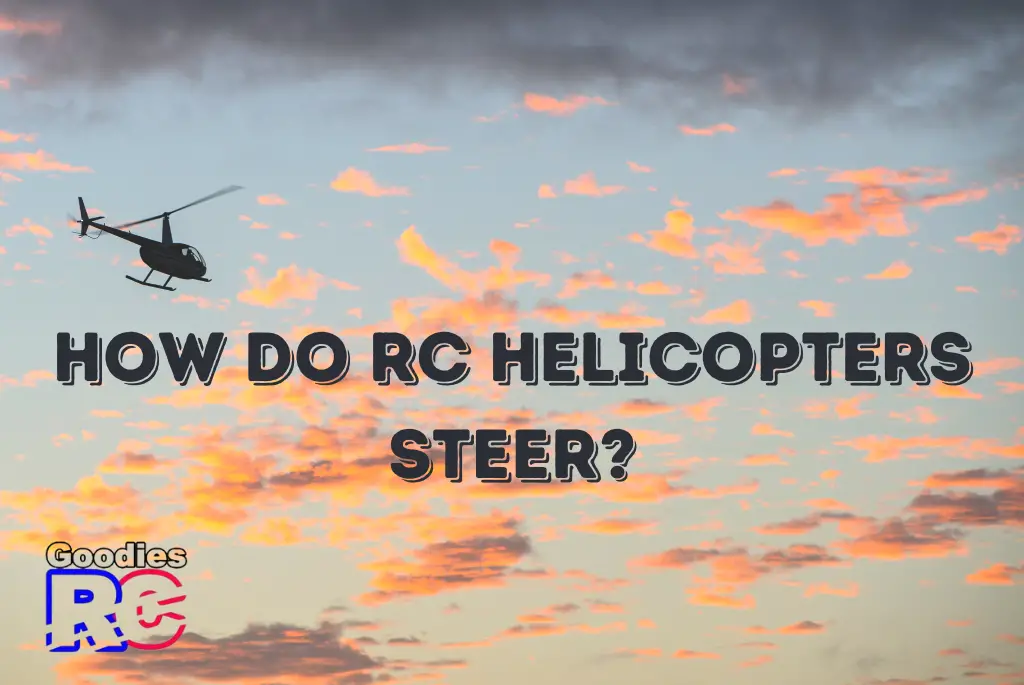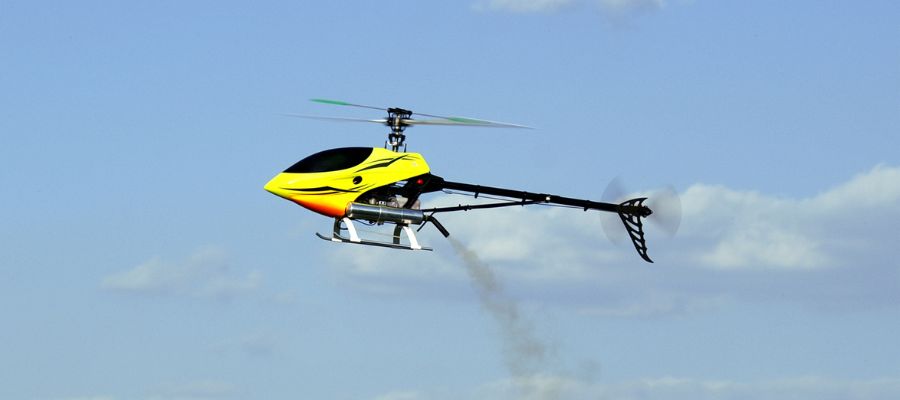Flying RC helicopters can be a fun and rewarding hobby, but it takes some commitment to learn how to control these aircraft. Understanding how RC helicopters steer is one of the fundamental aspects of learning to fly these RC aircraft. Our guide will give you a starting point to understand the basics of how RC helicopters steer.
RC helicopters are steered by the cyclic and collective control of the main rotors. Changing the angle-of-attack of the individual rotors and rotor disc gives left and right banking, forward and backward movement, and altitude change. Yaw is provided by the tail rotor or coaxial main rotor.
RC helicopters can be one of the most challenging RC aircraft to fly due to the complexity of the controls and the understanding needed to make the helicopter go where you want it to go! Fortunately, RC helicopters have various levels of complexity, making steering the simpler helicopters easier.

How To Steer RC Helicopters
RC helicopters can be intimidating to many first-time flyers, especially for those new to the RC hobby. As with most types of RC vehicles, you can start with entry-level aircraft that offer a lower learning curve rather than jumping into the deep end with a complex model that closely imitates real-life helicopters.
Understanding the difference between the different types of RC helicopters will help you to make the right choice in an RC helicopter for your skill level. Many people start with a too complex model, crash the helicopter on their first flight, and give up the hobby as too hard to master.
Related post: Is Your RC Helicopter Flying Sideways? Here’s What To Do
Learning to fly certain RC helicopters can be challenging, even for RC hobbyists experienced with other RC aircraft. It is best to ease into helicopter flying by selecting easier-to-fly RC helicopter configurations as a beginner.
There are several movements along different axes that you need to understand to control and steer your RC helicopter. The main movements to steer your RC helicopter are left, right, forward, backward, up, and down.
Understanding the mechanics of how an RC helicopter changes direction and the terminology used will give you a better understanding of how to control your helicopter.
Cyclic And Collective Pitch Control To Steer RC Helicopters
The main rotor blades of a helicopter play an important role in steering and controlling the RC helicopter. Different mechanisms are used to control the main rotors, affecting how difficult it is to fly each type of helicopter.
We will touch on control difficulty as we address each control mechanism type used in RC helicopters to control the rotors.
Cyclic Pitch In RC Helicopters
The spinning rotors on a helicopter create an imaginary disc, or circle, drawn in the air by the tips of the rotor blades. This imaginary circle is called the rotor disc. The tilt of this rotor disc is called cyclic control and affects the directional control or steering of the helicopter.
The entire rotor disc is tilted by the swashplate, which is a mechanism at the rotor head that tilts in any direction to control cyclic pitch and up and down to control collective pitch.
If the rotor disc is tilted forward so that the rotors are spinning at a lower angle at the front of the helicopter and a higher angle at the rear, the helicopter will move forward. When the tilt orientation is reversed, the helicopter will move backward.
If the rotor disc is tilted to the right, the rotor blades spin lower on the helicopter’s right side than on the left, and the helicopter will bank to the right. Switching the tilt orientation to be lower on the left than on the right will bank the helicopter to the left.
Tilting the rotor disc changes the angle at which the lift force of the rotors is directed, which forces the helicopter in one direction or the other.
A feature of RC helicopters that is not present in real-life helicopters is the flybar. The flybar is a rod positioned perpendicular to the rotors and has a fin or paddle-shaped aerofoil at each end of the rod. The flybar assists in the tilting mechanism of the rotors and help to stabilize the helicopter in the air.
The flybar is not present in all RC helicopters, and its full function is not relevant here, so we will address the flybar in a separate article, “RC Helicopter Flybars Explained“
Collective Pitch In RC Helicopters

There are two types of collective pitch control in RC helicopters; fixed pitch and collective pitch. The cyclic pitch works the same on the RC helicopter whether you have fixed pitch rotor control or collective pitch rotor control.
The pitch of the individual rotor blades is the twist along their longitudinal axis, which changes the angle of attack of the leading edge of the rotor. This controls the amount of lift generated by the rotors and, thus, controls the altitude of the helicopter.
Fixed pitch rotors are, as the name suggests, fixed at the rotor head and cannot be tilted on their longitudinal axis. This fixed position means that to increase altitude, the rotors must spin faster to produce more lift. Conversely, the rotors are slowed down to reduce lift to decrease altitude.
Collective pitch rotors are able to twist or pivot along their longitudinal axis, changing the angle of attack of the leading edge of the rotor. Increasing the angle of attack increases lift, while reducing the angle of attack reduces lift.
The altitude of collective pitch rotor helicopters can thus be adjusted without the necessity of adjusting the rotor speed.
Fixed pitch or FP rotor helicopters are easier to fly than collective pitch or CP rotor helicopters, but they are less sensitive to control changes. There is a perceived lag between sending the signal to increase or decrease altitude because the motor takes longer to increase or reduce the rotor speed.
Collective pitch control rotors are more responsive and have fine control, making the response to control signals smoother and more immediate. CP helicopters do not have a flybar since the individual rotor pitch control replaces their function.
CP helicopters respond more like real-life helicopters and are consequently more challenging to operate and master. However, this challenge is what attracts many RC hobbyists to helicopter flying.
The greater control of the collective pitch rotor helicopter types makes them more suitable for aerobatics than fixed pitch helicopters. This difference is especially evident for inverted flying, which is not possible with fixed pitch rotors.
Using Yaw To Steer RC Helicopters
Yaw is the action of pivoting or turning an aircraft, so the nose is pointing left or right from the original position. The pivot movement is around the aircraft’s vertical axis, and when combined with banking the helicopter, a fast turn left, or right can be achieved.
In real-life helicopters, the yaw is controlled by the tail rotor speed. The tail rotor counterbalances the torque from the main rotor, which makes the helicopter body or chassis spin in the opposite direction to the rotor spin.
The tail rotor speed can control the yaw in the desired direction to cause the helicopter to pivot left or right on the vertical axis.
This principle works exactly the same for RC helicopters fitted with a tail rotor. However, not all RC helicopters have a tail rotor.
Coaxial rotor RC helicopters have two main rotors, one vertically above the other, each spinning in opposite directions. The opposite direction of spin counteracts the rotational torque of the other rotor and effectively cancels it out, making a tail rotor obsolete.
The same yaw effect is achieved in coaxial rotor helicopters by slowing down the respective rotor to achieve the desired yaw direction.
2-Channel Vs. 4-Channel Control Helicopters
Hobby-grade RC helicopters need 4-channel transmitters to properly control the aircraft and achieve smooth flight.
Many toy-grade RC helicopters are sold as “beginner” helicopters with 2-channel control and are advertised as being easier to fly.
In reality, the 2-channel helicopters do not offer enough control to produce stable flight and can be frustrating for new RC helicopter flyers to control.
These helicopters also do not give a true “feel” of what it is like to fly a hobby-grade helicopter and therefore have no value as an entry-level or starter RC helicopter.
Read my guide for a better understanding of RC channels
If you want to start flying RC helicopters, I recommend a 4-channel Fixed Pitch coaxial helicopter. This helicopter type will offer more realistic controls that make for an easier transition to the more complex collective pitch RC helicopters.
Conclusion
Helicopters, in general, are complicated machines that are difficult to steer. Understanding the mechanics behind the forces that steer the RC helicopter makes it easier to relate to the controls on the transmitter.
Stick with the challenge of maneuvering your RC helicopter; you will soon get the hang of it and be flying your helicopter with a few deft tweaks on the controls!
